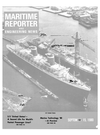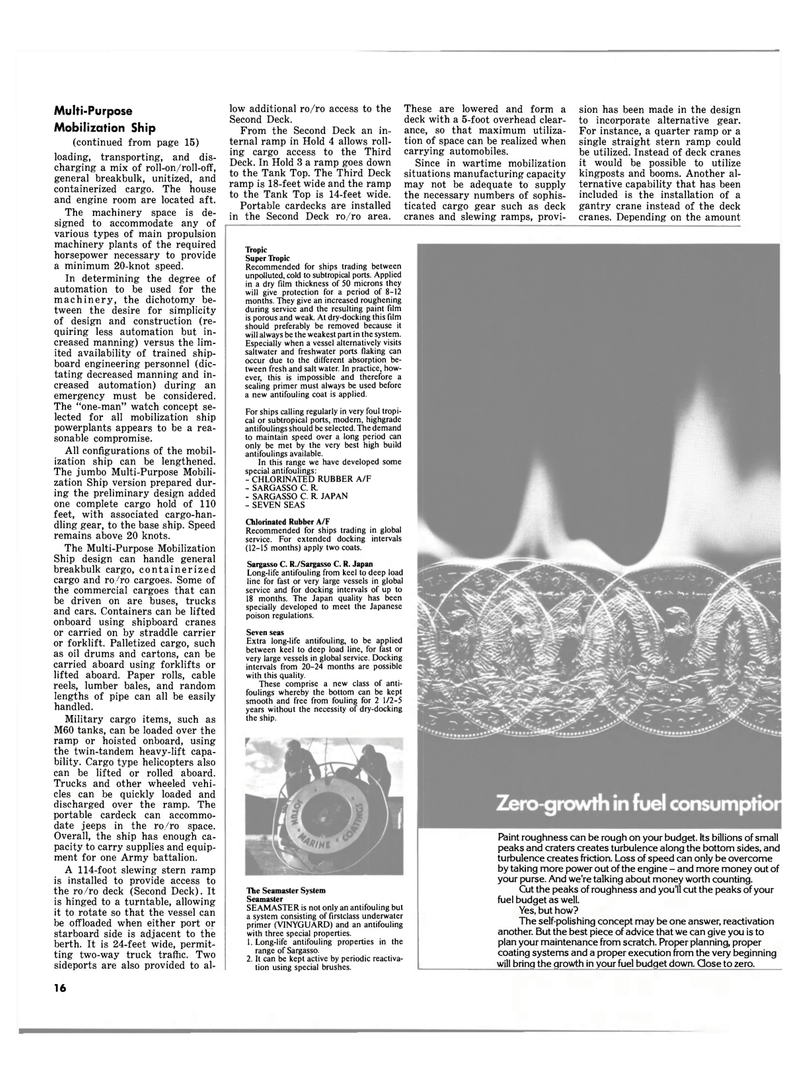
Page 14: of Maritime Reporter Magazine (September 15, 1980)
Read this page in Pdf, Flash or Html5 edition of September 15, 1980 Maritime Reporter Magazine
Multi-Purpose
Mobilization Ship (continued from page 15) loading, transporting, and dis- charging a mix of roll-on/roll-off, general breakbulk, unitized, and containerized cargo. The house and engine room are located aft.
The machinery space is de- signed to accommodate any of various types of main propulsion machinery plants of the required horsepower necessary to provide a minimum 20-knot speed.
In determining the degree of automation to be used for the machinery, the dichotomy be- tween the desire for simplicity of design and construction (re- quiring less automation but in- creased manning) versus the lim- ited availability of trained ship- board engineering personnel (dic- tating decreased manning and in- creased automation) during an emergency must be considered.
The "one-man" watch concept se- lected for all mobilization ship powerplants appears to be a rea- sonable compromise.
All configurations of the mobil- ization ship can be lengthened.
The jumbo Multi-Purpose Mobili- zation Ship version prepared dur- ing the preliminary design added one complete cargo hold of 110 feet, with associated cargo-han- dling gear, to the base ship. Speed remains above 20 knots.
The Multi-Purpose Mobilization
Ship design can handle general breakbulk cargo, containerized cargo and ro/ro cargoes. Some of the commercial cargoes that can be driven on are buses, trucks and cars. Containers can be lifted onboard using shipboard cranes or carried on by straddle carrier or forklift. Palletized cargo, such as oil drums and cartons, can be carried aboard using forklifts or lifted aboard. Paper rolls, cable reels, lumber bales, and random lengths of pipe can all be easily handled.
Military cargo items, such as
M60 tanks, can be loaded over the ramp or hoisted onboard, using the twin-tandem heavy-lift capa- bility. Cargo type helicopters also can be lifted or rolled aboard.
Trucks and other wheeled vehi- cles can be quickly loaded and discharged over the ramp. The portable cardeck can accommo- date jeeps in the ro/ro space.
Overall, the ship has enough ca- pacity to carry supplies and equip- ment for one Army battalion.
A 114-foot slewing stern ramp is installed to provide access to the ro/ro deck (Second Deck). It is hinged to a turntable, allowing it to rotate so that the vessel can be offloaded when either port or starboard side is adjacent to the berth. It is 24-feet wide, permit- ting two-way truck traffic. Two sideports are also provided to al- low additional ro/ro access to the
Second Deck.
From the Second Deck an in- ternal ramp in Hold 4 allows roll- ing cargo access to the Third
Deck. In Hold 3 a ramp goes down to the Tank Top. The Third Deck ramp is 18-feet wide and the ramp to the Tank Top is 14-feet wide.
Portable cardecks are installed in the Second Deck ro/ro area.
These are lowered and form a deck with a 5-foot overhead clear- ance, so that maximum utiliza- tion of space can be realized when carrying automobiles.
Since in wartime mobilization situations manufacturing capacity may not be adequate to supply the necessary numbers of sophis- ticated cargo gear such as deck cranes and slewing ramps, provi- sion has been made in the design to incorporate alternative gear.
For instance, a quarter ramp or a single straight stern ramp could be utilized. Instead of deck cranes it would be possible to utilize kingposts and booms. Another al- ternative capability that has been included is the installation of a gantry crane instead of the deck cranes. Depending on the amount
Tropic
Super Tropic
Recommended for ships trading between unpolluted, cold to subtropical ports. Applied in a dry film thickness of 50 microns they will give protection for a period of 8-12 months. They give an increased roughening during service and the resulting paint film is porous and weak. At dry-docking this film should preferably be removed because it will always be the weakest part in the system.
Especially when a vessel alternatively visits saltwater and freshwater ports flaking can occur due to the different absorption be- tween fresh and salt water. In practice, how- ever, this is impossible and therefore a sealing primer must always be used before a new antifouling coat is applied.
For ships calling regularly in very foul tropi- cal or subtropical ports, modern, highgrade antifoulings should be selected. The demand to maintain speed over a long period can only be met by the very best high build antifoulings available.
In this range we have developed some special antifoulings: - CHLORINATED RUBBER A/F - SARGASSO C. R. - SARGASSO C. R. JAPAN - SEVEN SEAS
Chlorinated Rubber A/F
Recommended for ships trading in global service. For extended docking intervals (12-15 months) apply two coats.
Sargasso C. R./Sargasso C. R. Japan
Long-life antifouling from keel to deep load line for fast or very large vessels in global service and for docking intervals of up to 18 months. The Japan quality has been specially developed to meet the Japanese poison regulations.
Seven seas
Extra long-life antifouling, to be applied between keel to deep load line, for fast or very large vessels in global service. Docking intervals from 20-24 months are possible with this quality.
These comprise a new class of anti- foulings whereby the bottom can be kept smooth and free from fouling for 2 1/2-5 years without the necessity of dry-docking the ship.
The Seamaster System
Seam aster
SEAMASTER is not only an antifouling but a system consisting of firstclass underwater primer (VINYGUARD) and an antifouling with three special properties. 1. Long-life antifouling properties in the range of Sargasso. 2. It can be kept active by periodic reactiva- tion using special brushes.
Paint roughness can be rough on your budget. Its billions of small peaks and craters creates turbulence along the bottom sides, and turbulence creates friction. Loss of speed can only be overcome by taking more power out of the engine - and more money out of your purse. And we're talking about money worth counting.
Cut the peaks of roughness and you'll cut the peaks of your fuel budget as well.
Yes, but how?
The self-polishing concept may be one answer, reactivation another. But the best piece of advice that we can give you is to plan your maintenance from scratch. Proper planning, proper coating systems and a proper execution from the very beginning will bring the growth in your fuel budget down. Close to zero. 16

 13
13

 15
15
